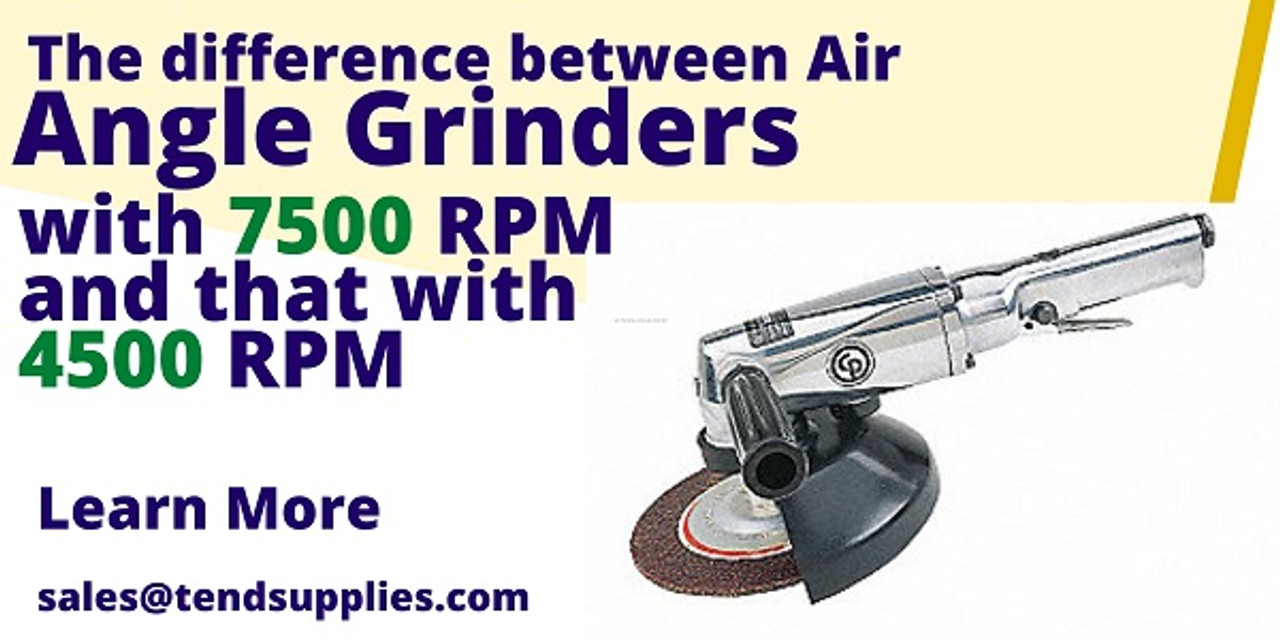The difference between air angle grinders with 7500 RPM and that with 4500 RPM
Here is the audio of this Article
Before buying power tools, workshops need to read and understand some of the technical terms on the product labels and their implications, especially air tools. This article details the difference between air angle grinders with 7500 rpm and that with 4500 rpm, their uses, and the reason for their preferences.
How does the air angle grinder work?
An air angle grinder, also called a pneumatic angle grinder, is a powerful tool that uses compressed air to rotate an abrasive disc at high speeds. The compressed air is supplied to the tool through an air hose connected to an air compressor.
When the trigger on the air angle grinder is pulled, the compressed air flows through the tool, spinning the disc at high speeds. The speed of the disc can be adjusted by adjusting the pressure of the compressed air supplied to the tool. The user can then hold the tool at a specific angle and use the spinning disc to grind, cut, or sand various materials.
The air angle grinder typically has a handle or grip that allows the user to hold the tool with one hand while the other controls the angle and position of the disc. The angle of the disc can be adjusted by loosening a lever or knob on the tool and then repositioning the disc to the desired angle. Safety precautions should always be taken when using an air angle grinder, including wearing proper personal protective equipment, such as safety glasses and gloves, and ensuring that the work area is free of debris.
The importance of the rating: Rotations per minute (RPM)
The RPM (rotations per minute) rating is an essential factor in air angle grinders because it determines the speed at which the abrasive disc spins. This, in turn, determines how quickly and efficiently the tool can remove material and the quality of the finish on the workpiece.
The difference between Pneumatic air angle grinders with 7500RPM and 4500 RPM
A 7-inch air angle grinder with 7,500 RPM (rotations per minute) would be considered a powerful and high-speed tool for grinding, cutting, and sanding various materials. The 7-inch disc size is larger than most standard angle grinders, which typically have 4-5 inch discs, so it can handle larger, more heavy-duty tasks. The high RPM also makes it more efficient for faster material removal. Additionally, being powered by an air compressor makes it more portable and versatile, as it does not require an electrical outlet to operate. This feature is particularly useful for outdoor or remote work environments where access to electricity is limited.
A 7-inch air angle grinder with 4,500 RPM (rotations per minute) is a powerful tool for grinding, cutting, and sanding various materials. The 7-inch disc size is larger than most standard angle grinders, which typically have 4-5 inches discs, so it can handle larger, more heavy-duty tasks.
The lower RPM (compared to 7500 RPM) can have some advantages, such as:
- Greater control: The lower speed allows for more precise control when working on delicate materials or intricate projects.
- Reduced heat: Lower RPM generates less heat, which can be beneficial when working on heat-sensitive materials, such as plastics or painted surfaces.
- Increased disc life: Lower speed can increase the life of the disc, as it reduces wear and tear on the disc and prolongs its useful life.
- Reduced noise: Lower speed also reduces the tool's noise, which can be beneficial in environments where noise is a concern.
- Better for fine finishing: Lower speed is better for fine finishing applications, providing a smoother finish.
The lower RPM may be more suitable for detailed and precise work, while the higher RPM is better for heavy-duty and fast material removal tasks.
Conclusion.
The choice between a 7-inch air angle grinder with a 4,500 RPM rating and a 7,500 RPM rating depends on the specific task and the user's preferences.
- A 7-inch air angle grinder with a 7,500 RPM rating would be more efficient for heavy-duty tasks such as quickly removing large amounts of material and rough grinding. It's also more suitable for fast cutting and sanding.
- A 7-inch air angle grinder with a 4,500 RPM rating would provide more precise control and a smoother finish, making it more suitable for delicate materials or intricate projects. It's also better for fine finishing and polishing.
For heavy-duty tasks like metal cutting, rust removal, grinding, and sanding, a 7-inch air angle grinder with a 7,500 RPM rating would be the better choice, as it can remove material quickly and efficiently. However, for detailed and precise work, such as polishing and fine finishing (required mostly in automotive workshops), a 7-inch air angle grinder with a 4,500 RPM rating would be more suitable, as it can provide a smoother finish and better control.
Ultimately, choosing between a 4,500 RPM and 7,500 RPM air angle grinder depends on the specific task and the user's preferences. It's also important to consider the safety precautions required for each RPM level.









